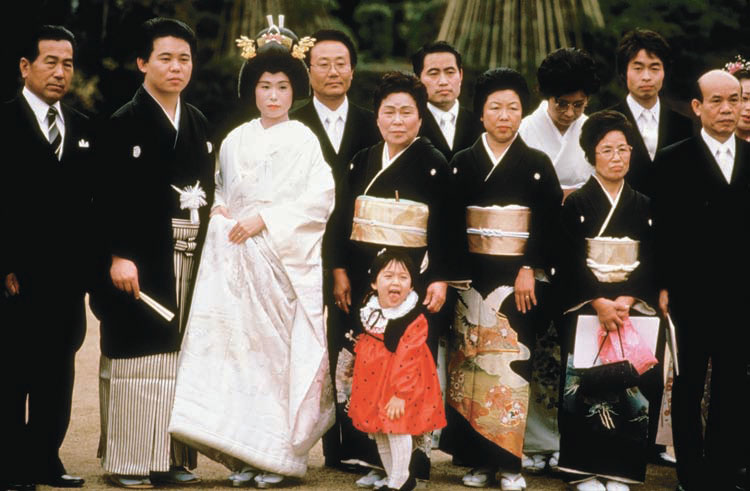11.2
Emotion and Culture
A young wife leaves her house one morning to draw water from the local well as her husband watches from the porch. On her way back from the well, a male stranger stops her and asks for some water. She gives him a cupful and then invites him home to dinner. He accepts. The husband, wife, and guest have a pleasant meal together. In a gesture of hospitality, the husband invites the guest to spend the night with his wife. The guest accepts. In the morning, the husband leaves early to bring home breakfast. When he returns, he finds his wife again in bed with the visitor.
At what point in this story will the husband feel angry? The answer depends on his culture (Hupka, 1981, 1991). A North American husband would feel rather angry at a wife who had an extramarital affair, and a wife would feel rather angry at being offered to a guest as if she were a lamb chop. But a Pawnee husband of the 19th century would be enraged at any man who dared ask his wife for water. An Ammassalik Inuit husband finds it perfectly honorable to offer his wife to a stranger, but only once; he would be angry to find his wife and the guest having a second encounter. And a century ago, a Toda husband in India would not have been angry at all because the Todas allowed both husband and wife to take lovers. Both spouses might feel angry, though, if one of them had a sneaky affair, without announcing it publicly.
In most cultures, people feel angry in response to insult and the violation of social rules, but as this story shows, they often disagree about what an insult or correct rule is. In this section, we will explore how culture influences the emotions we feel and the ways in which we express them.
How Culture Shapes Emotions
Are some emotions specific to particular cultures and not found elsewhere? What does it mean that some languages have words for subtle emotional states that other languages lack? The Germans have schadenfreude, a feeling of joy at another's misfortune. The Japanese speak of hagaii, helpless anguish tinged with frustration. Tahitians have mehameha, a trembling sensation that Tahitians feel when ordinary categories of perception are suspended—at twilight, in the brush, watching fires glow without heat. In the West, an event that cannot be identified is usually greeted with fear, yet mehameha does not describe what Westerners call fear or terror (Levy, 1984). Culture also shapes and labels the experience of blends of emotions, as in the English word bittersweet or the mixed emotions of pleasure and regret in nostalgia. But English lacks an emotion word that is central to inhabitants of the tiny Micronesian atoll of Ifaluk: fago, translated as “compassion/love/sadness,” which reflects the sad feeling one has when a loved one is absent or in need, and the pleasurable sense of compassion in being able to care and help (Lutz, 1988).
Do these interesting linguistic differences mean that Germans are more likely than others actually to feel schadenfreude, the Japanese to feel hagaii, and the Tahitians to feel mehameha? Or are they just more willing to give these subtle emotions a name? Most people in all cultures are capable of feeling certain innate emotions, the ones that have physiological hallmarks in the brain and nervous system. But people in different cultures might indeed differ in their abilities to experience emotional blends and variations such as schadenfreude, hagaii, or mehameha.
The difference between innate emotions and more complex cultural variations seems to be reflected in languages all over the world (Hepper et al., 2014). Aprototype is a typical representative of a class of things. People everywhere consider some emotions to be prototypical examples of the concept emotion: Thus, most people will say that anger and sadness are more representative of an emotion than irritability and nostalgia are. Prototypical emotions are reflected in the emotion words that young children learn first: happy, sad, mad, and scared. As children develop, they begin to draw emotional distinctions that are less prototypical and more specific to their language and culture, such as ecstatic, depressed, hostile, or anxious (Hupka, Lenton, & Hutchison, 1999; Shaver, Wu, & Schwartz, 1992). And their appraisals of a given situation or provocation will also vary—as we saw earlier in describing the difference between Americans and Japanese—depending on their culture's values, norms, and traditions. In this way, children and adults come to experience the nuances of emotional feeling that their cultures emphasize. The result is many varieties of emotion, some shading into one another, which have labels in some languages but not in others.
All emotions depend on the culture and context that produce them and shape their expression. Anger may be universal, but the way it is experienced will vary from culture to culture—whether it feels good or bad, useful or destructive. And cultures determine much of what people feel emotional about. For example, disgust is universal, but the content of what produces disgust changes as an infant matures, and it varies across cultures (Rozin, Lowery, & Ebert, 1994). People in some cultures learn to become disgusted by bugs (which other people find beautiful or tasty), unfamiliar sexual practices, dirt, death, contamination by a handshake with a stranger, or particular foods (e.g., meat if they are vegetarian, or pork if they are Muslims or Orthodox Jews).

What you feel about the idea of consuming this insect depends on the culture you are from.
Communicating Emotions
Suppose that someone who was dear to you died. Would you cry, and if so, would you do it alone or in public? Your answer will depend in part on your culture's display rules for emotion (Ekman et al., 1987; Gross, 1998; Hayashi & Shiomi, 2015). In some cultures, grief is expressed by weeping; in others, by tearless resignation; and in still others, by dance, drink, and song. When you feel an emotion, how you express it is rarely a matter of “I say what I feel.” You may be obliged to disguise what you feel. You may wish you could feel what you say.
Even the smile, which seems a straightforward signal of friendliness, has many meanings and uses that are not universal (LaFrance, 2011). Americans smile more frequently than Germans, not because Americans are inherently friendlier but because they differ in their notions of when a smile is appropriate. After a German–American business meeting, the Americans often complain that the Germans were cold and aloof, and the Germans often complain that the Americans were excessively cheerful, hiding their real feelings under the mask of a smile (Hall & Hall, 1990). The Japanese smile even more than Americans do, to disguise embarrassment, anger, or other negative emotions whose public display is considered rude and incorrect.
Display rules also govern body language, nonverbal signals of body movement, posture, gesture, and gaze (Birdwhistell, 1970). Many aspects of body language are specific to particular languages and cultures, which makes even the simplest gesture subject to misunderstanding and offense (Matsumoto & Hwang, 2013). The sign of the University of Texas at Austin football team, the Longhorns, is to extend the index finger and the pinkie. In Italy and other parts of Europe, it means you're saying a man's wife has been unfaithful to him—a serious insult.
Display rules tell us not only what to do when we are feeling an emotion, but also how and when to show an emotion we do not feel. Most people are expected to demonstrate sadness at funerals, happiness at weddings, and affection toward relatives. What if we don't actually feel sad, happy, or affectionate? Acting out an emotion we do not really feel because we believe it is socially appropriate is called emotion work. It is part of our efforts to regulate our emotions when we are with others (Gabriel et al., 2015; Gross, 1998). Sometimes emotion work is a job requirement. Flight attendants, waiters, and customer-service representatives must put on a happy face to convey cheerfulness, even if they are privately angry about a rude or drunken customer. Bill collectors must put on a stern face to convey threat, even if they feel sorry for the person they are collecting money from (Hochschild, 2003).

Around the world, the cultural rules for expressing emotions differ. The display rule for a formal Japanese wedding portrait is “no direct expressions of emotion,” but not every member of this family has learned that rule yet.
Gender and Emotion
“Women are too emotional,” men often complain. “Men are too uptight,” women often reply. This is a familiar gender stereotype. Generally, when people say that women are “emotional,” they are not thinking of the overwhelming evidence that far more men than women “lose their cool” by getting into fistfights and killing each other. What, then, does “too emotional” mean? We need to define our terms and examine our assumptions. And we need to consider the larger culture in which men and women live, which shapes the rules and norms that govern how the sexes are supposed to behave.
Although women are more likely than men to suffer from clinical depression, neither sex feels any of the everyday emotions more often than the other, whether the emotion is anger, worry, embarrassment, anxiety, love, or grief (Archer, 2004; Deffenbacher et al., 2003; Fischer et al., 1993; G. Harris, 2003; Kring & Gordon, 1998; Shields, 2005). The major difference between the sexes has less to do with whether they feel emotions than with how and when their emotions are expressed, and how others perceive those expressions.
In Western cultures, both sexes unconsciously associate “angry” with male and “happy” with female. When researchers showed students a series of computer-generated, fairly sex-neutral faces with a range of angry to happy expressions, the students consistently rated the angry faces as being masculine and the happy faces as feminine (Becker et al., 2007). This stereotyped link between gender and emotion may explain why a man who expresses anger in a professional context is considered high status, but a professional woman who does exactly the same thing loses status. She's considered to be an angry person, someone “out of control” (Brescoll & Uhlmann, 2008). Powerful women thus often face a dilemma: express anger when a subordinate or adversary has done something illegal or incompetent (and risk being thought “overemotional”) or behave calmly (and risk being seen as “cold and unemotional”).
Conversely, women who don't smile when others expect them to are often disliked, even if they are actually smiling as often as men would. This may be why North American women, on average, smile more than men do, gaze at their listeners more, have more emotionally expressive faces, use more expressive hand and body movements, and touch others more (DePaulo, 1992; Kring & Gordon, 1998). Women smile more than men to pacify others, convey deference to someone of higher status, or smooth over conflicts (Hess, Adams, & Kleck, 2005; LaFrance, 2011; Shields, 2005).
American women also talk about their emotions more than men do. They are far more likely to cry and to acknowledge emotions that reveal vulnerability and weakness, such as “hurt feelings,” fear, sadness, loneliness, shame, and guilt (Grossman & Wood, 1993; Timmers, Fischer, & Manstead, 1998). In contrast, most American men express only one emotion more freely than women do: anger toward strangers, especially other men. Otherwise, men are expected to control and mask negative feelings. When they are worried or afraid, they are more likely than women to use vague terms, saying that they feel moody, frustrated, or on edge (Fehr et al., 1999).
However, the influence of a particular situation often overrides gender rules. You won't find many gender differences in emotional expressiveness at a football game or the World Series! Furthermore, both sexes do similar emotion work when the situation or job requires it. A male flight attendant has to smile as much with passengers as a female attendant does, and a female FBI agent has to be as emotionally strong and controlled as a male agent. One of the most important situational constraints on emotional expression is the status of the participants, whatever their gender (Kenny et al., 2010; Snodgrass, 1992). A man is as likely as a woman to control his temper when the target of anger is someone with higher status or power; few people will readily sound off at a professor, police officer, or employer. As for empathy in judging other people's emotions, supposedly a “female” skill, a series of experiments found that working-class people of both sexes are more skilled in empathic accuracy—judging emotional expressions in others and reading the emotions of strangers in job interviews—than upper-class people are. Working-class women and men have a greater interest in being able to read the nonverbal cues of those who have higher status and more power than they (Kraus, Côté, & Keltner, 2010).

Both sexes feel emotionally attached to friends, but often they express their affections differently. From childhood on, girls tend to prefer “face-to-face” friendships based on shared feelings; boys tend to prefer “side-by-side” friendships based on shared activities.
Even when gender differences exist, they are not universal. Italian, French, Spanish, and Middle Eastern men and women can have entire conversations using highly expressive hand gestures and facial expressions. In contrast, in Asian cultures, both sexes are taught to control emotional expression (Matsumoto, 1996; Mesquita & Frijda, 1992). Israeli and Italian men are more likely than women to mask feelings of sadness, but British, Spanish, Swiss, and German men are less likely than their female counterparts to inhibit this emotion (Wallbott, Ricci-Bitti, & Bänninger-Huber, 1986).
In sum, the answer to “Which sex is more emotional?” is sometimes men, sometimes women, and sometimes neither, depending on the circumstances and their culture—and how we define our terms.